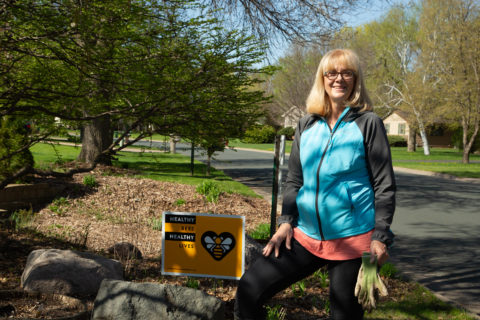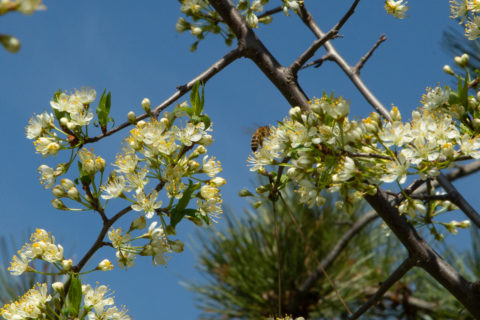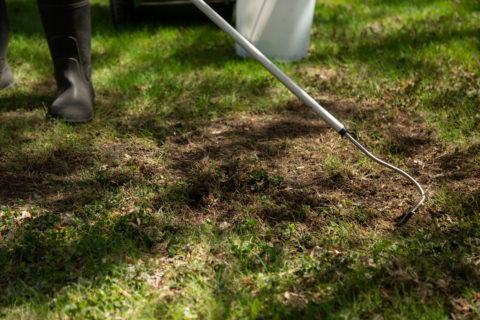Story and photos courtesy Clean Water Minnesota.
A master gardener and longtime homeowner on the shores of Andover’s Crooked Lake, Cheryl Seeman has gradually transformed her lawn into a wildlife and pollinator sanctuary. “They call me the Queen Bee,” said Cheryl with a laugh.

From the front curb, it’s obvious that featureless green grass isn’t Cheryl’s priority. The lawn is dotted with white clover and dandelion blooms. A wide rain garden borders a curbside city storm drain, and garden signs announce that this is pollinator-friendly territory. Sprawling garden beds are already lush and blooming. They lead the eye to the back yard, which slopes down to the lakeshore where red-winged blackbirds chirp and flit between tall reeds.
Crooked Lake is one of the cleanest lakes in the metro, but it wasn’t always that way. Over the years, Cheryl witnessed firsthand the cumulative effect of chemical lawn treatments and pollution as milfoil shrouded the surface of the lake. Years of treatment have restored the lake’s clear waters, but Cheryl recognized this as a microcosm of global water issues. She’s dedicated to making a positive environmental impact by “saving the globe one yard at a time.”
Creating a yard that’s hospitable to pollinators is an ongoing process. Cheryl embraces the cycles of the season as opportunities to evolve her garden — and gradually reduce the amount of lawn. Her enthusiasm for environmentally responsible yard care has had a ripple effect. Kids visit her garden to search for caterpillars, and most of her neighbors have stopped treating their own lawns with chemicals.
Cheryl’s passion for environmental education extends far beyond her neighborhood. She’s part of the Andover Pollinator Awareness Project, a group of like-minded gardeners and citizens who share information about pollinator-friendly practices through classes and outreach. This coming July, the Pollinator Awareness Project will lead a garden tour through Cheryl’s yard in hopes of inspiring others to plant for pollinators in their own yards.
What makes a Bee Lawn?
Planting a “bee lawn” is probably easier than you think. A bee lawn is a mix of low-growing perennials and grasses that can be mowed like any other lawn while also providing nutrition to pollinators. By mixing different species of short flowers, bee lawns provide food for the many different kinds of bees that populate our landscape.

Most often a bee lawn seed blend is a combination of white clover, creeping thyme, and self heal. Fine fescue grasses can also be incorporated into the mix. Their longer root systems and slow growth will require less mowing and water than other grasses.
Bee lawns are particularly well suited to areas of a yard that are otherwise challenging to keep green such as a steep slope or boulevard. Taller flowers such as prairie groundsel and calico aster don’t tolerate mowing, but they make a lovely border to a bee lawn.
Cheryl encourages gardeners to seed the bee lawn in spring, when the ground is soft, and in fall. She also suggests planting a variety of trees and bushes that bloom throughout the season. Her yard includes cherry bushes, a Native American Plum tree, lilacs, and a cork tree. She also recommends the following plants for pollinators: mulleins, Alliums, ground Sedums, hyssop, and goldenrod.
“Bees are looking for the same nutrition we are. Pollen provides amino acids and proteins,” Cheryl said. Providing a bouquet of different flowering plants in a yard feeds a wider variety of pollinators. She also embraces what she calls “messy gardening” by using last fall’s leaves to mulch her garden beds. This minimizes yard waste and provides a habitat for moth, butterflies and bees to burrow and lay their eggs. “If you clean it up, you throw the kids away!”
Let go of the idea of a pristine, green lawn and try messy gardening in your yard. Follow these simple tips to welcome nature into your backyard habitat. Soon you may have your own small sanctuary, alive with bees and songbirds.
How to grow a Bee Lawn

1. Prep your yard by mowing the lawn as short as you can and aerating the soil. You can scrape the soil of weeds or simply overseed existing patches of grass.
2. Create your own Bee Lawn Mix with seeds from a local vendor such as Mother Earth Gardens, Prairie Restoration, and Minnesota Native Landscapes.
Click here for a suggested seed mix from Minnesota Native Landscapes to cover 1,000 square feet: a blend of Low Grow Fescue Mix, Dutch white clover, creeping thyme, and self-heal.
3. Water if needed, or seed before rainy weather.
4. Once established, keep the bee lawn at least 3 inches tall to prevent moisture from evaporating. Weed your bee lawn by hand, and avoid the use of herbicides.
Read the original post on cleanwatermn.org
Bee-ing Pollinator Friendly in CRWD
Transitioning to a bee lawn works well for the smaller yards and boulevards found in Capitol Region Watershed District (CRWD). White clover is already found in many grassy areas of CRWD and can be easily incorporated into existing lawns.
Landscape with native species, drought-tolerant grasses and rain gardens. Native plants provide food for pollinators, filter stormwater runoff before it reaches nearby lakes and rivers, and require less watering than most traditional lawns and gardens.
Leave grass clippings and leaves in your yard. Mulching with leaves provides habitat for pollinators and other beneficial insects while reducing organic debris that could go down the storm drain. Keeping leaves and grass out of streets helps prevent algae blooms in our lakes.
